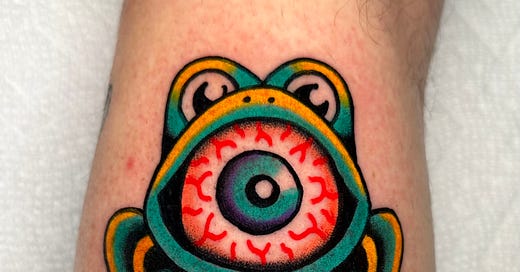Ink, diamonds, and bootstraps
North of Boston, a tattoo artist at work and a shoe designer's donation
There’s a trope about parents who don’t want their kids to become artists because there’s no money in it. But there are so many avenues to artistic professions. Chris Coulon, a/k/a Tallboy. is a tattoo artist at North Street Tattoo in Salem. He started out designing T-shirts as an intern at a screen-printing shop, and that led to designing boards for Santa Cruz Skateboards. He’d always been inspired by Jim Phillips skateboard designs at Santa Cruz, which reach back 40 or more years.
But working alone in his studio, emailing designs across the country, Chris got cabin fever. So he learned how to tattoo. Now he’s a full-time tattoo artist (and he makes $200 an hour), inking intensely chromatic designs at North Street. “Here, I’m working with other artists, I’m working with people. I’m actually doing art on people,” he said.
The risk of being a working artist is that you lose the sense of play that probably first inspired you to make art. Chris has advice about work stress: “It’s important to take a step back and be like, ‘I’m drawing a skeleton under a mushroom next to a yin yang with a shark and a surfing guy on it,’” he said. “‘This is fun. This is what I’ve always wanted.’” You can read more about Chris in last week’s Working Artist.

Iconic shoe designer Stuart Weitzman has designed footwear for Beyoncé and Aretha Franklin, but he got his start back in the 1950s doing gruntwork at Mr. Seymour’s Shoes, his father’s factory in Haverhill. In time, he became the designer there, and the company moved offshore to Spain.
A century ago, the city was a beehive of shoe factories. “There were heel factories, sole factories, factories for adornments,” Weitzman said over the phone from his home in Greenwich, Connecticut.
Mr. Seymour Shoes was “really one of the last surviving shoe companies operating in Haverhill,” said fashion and design historian and curator Michelle Finamore. “It was pretty impressive that they lasted that long.”
Now Weitzman is returning – or at least his shoes are. Historic New England occupies the Lang Building in Haverhill, former home of Mr. Seymour’s. Last year, they purchased the Burgess Building next door, and several adjoining plots. The plan is to create the Haverhill Center for Preservation and Collections, a sprawling arts and culture hub that could bring tourists to the former factory town. Last month, Weitzman donated a portion of his shoe collection NHE.
“When my brother closed the factory, I took 100 shoes, samples, as mementoes of my dad’s work,” Weitzman said. The collection also includes his own designs and several antique shoes.
Next fall, that collection – including a model of the designer’s “Million Dollar Sandal,” which was studded with diamonds – will be at the center of “Shoe Stories,” the debut show with the opening of the Haverhill Center’s first space, an exhibition, programming, and welcome center. More in my Globe story.





Cool!